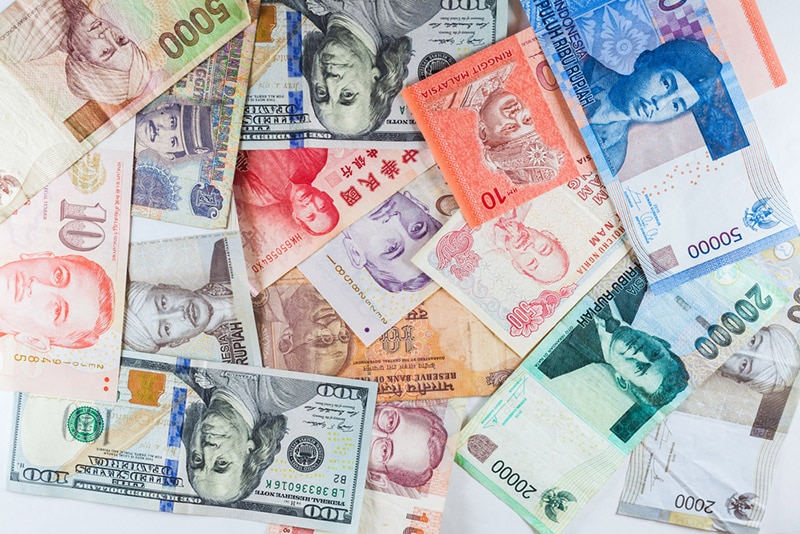
In the FX market, currencies are traded in pairs. These pairs are classified into majors, minors, and exotic pairs. Major pairs are the most popular currencies, and they are characterized by high liquidity and low spreads, which make them favorable to most traders. Minor pairs are the second most traded currencies, and they will technically have lower liquidity than the majors. However, since they include one of the major currencies other than the USD, they are still somewhat popular among traders.
Exotic pairs are composed of currencies from emerging and third world economies, and as such, have very low liquidity and high volatility. This makes them the riskiest pairs to trade, which is why beginners should avoid trading such currencies.
Exotic currency pairs
There are several fundamental factors that usually influence currency prices on the forex market. These include statistics such as inflation, trade deficit, interest rates, commodity prices, and employment reports. For major economies like the US, whenever such statistics are released, it makes major news, and thus predicting the price action of such a country’s currency is quite an easy feat.
Exotic currencies are the complete opposite. These currencies belong to developing countries, and they are seldom traded on the forex market. For instance, the EURUSD, a major pair, made up 23.1% of the daily FX transaction volume in 2016, while USDTRY, an exotic, made up only 1.3% of this volume. These exotics also tend to be highly volatile, as the economies behind them tend to be less stable.
Characteristics of popular exotic FX pairs
GBPZAR (British pound and South African Rand)
In this pair, the GBP is a major currency, while the ZAR is exotic. GBP’s value on the currency markets mainly depends on interest rate decisions by the Bank of England and other UK data such as inflation and employment reports.
The ZAR is classified as a commodity currency. This is because South Africa’s economy is heavily dependent on gold, their largest export. Thus, if gold prices rise, it is positive for the ZAR. Other significant exports from the country include iron ore, agricultural products, and platinum. Thus, traders wishing to trade this pair have to keep a close eye on the prices of these commodities, as well as the political environment in South Africa.
USDTHB (US dollar and Thailand Baht)
The USD is the most traded currency in the world, seeing as it’s the leading reserve currency, as well as the medium used for world trade and settling international debts. Its value is greatly impacted by Fed decisions on monetary policy, inflation levels, and US employment data.
The THB is an exotic currency that is famed for having little to no response to fluctuations in the Chinese economy. For that reason, it is preferred by many expert forex traders when the US and China have strained trade relations. The major factor affecting THB’s value is policy decisions from the Bank of Thailand.
EURTRY (Euro and Turkish Lira)
The Euro is used in 19 countries in the European continent, which makes it one of the most traded currencies globally, second only to the USD. The main factors impacting its price are policy decisions from the European Central Bank (ECB) and political and economic news from the 19 countries.
The TRY, in turn, used to be one of the lowest valued currencies. However, the country underwent economic reforms in 2005, which led to the recovery of its currency. However, in 2018, the country was riddled with a debt crisis which caused the Lira to devalue again. Since then, Turkey has adopted new monetary policies that have seen the Lira stabilize in value. Just last year, their required reserves were raised by 200 points.
AUDMXN (Australian dollar and Mexican peso)
The AUD is a major currency that’s classified as a commodity currency, seeing as its value heavily rides on the value of its exports. The commodities it exports include coal, iron ore, petroleum, and gold. Since Australia is the second biggest gold producer globally, gold prices have a strong effect on the value of their dollar. What’s more, since the majority of their exports are sent to China, the state of the Chinese economy heavily influences the AUD’s value.
Mexico also runs an economy that is heavily dependent on exports. Therefore, the factors that influence the peso’s price in the currency markets include trade policies and tariffs and any changes to the North American Free Trade Agreement (NAFTA). Any supply chain issues can also have a detrimental effect on the MXN.
JPYNOK (Japanese yen and Norwegian Krone)
The Japanese yen is a popular major currency. Due to its low-interest rates, it is highly favored by carry traders. The Krone, on the other hand, is an exotic currency that heavily depends on oil prices. This is because Norway’s economy is dependent on the oil they export, which speaks volumes to the value of its currency. Further, since it mostly trades with the UK, US, Germany, and France, the economies of these countries often impact NOK prices on the FX market.
USDSEK (US dollar and Swedish Krona)
Since we have already discussed the USD, let’s shift our focus to Sweden’s Krona. First, the Swedish economy is closely tied to that of its Nordic neighbors, Denmark and Norway. Sveriges Riksbank, the Swedish central bank, often makes monetary policy decisions that affect the SEK. Since 1992, this bank has maintained a floating exchange rate on its currency. They are currently considering a move to the Euro, but they cannot seem to get enough traction behind it.
The Krona is typically considered a safe-haven currency. In the face of global volatile market conditions, the SEK tends to stabilize or even rally at times. This can be attributed to the highly educated Swedish workforce. What’s more, its independence from oil prices makes the SEK a popular favorite among experts.
Conclusion
Exotic pairs comprise currencies from third-world or developing countries. Usually, such currencies are highly volatile as the economies behind them are seldom stable. This presents a large risk of loss for traders who are not intimately familiar with such currencies. What’s more, the shortage of information on such economies makes these exotic currencies especially difficult to trade for beginners. Fortunately, there are the popular most-traded currency pairs you can trade instead, as well as beginner-friendly currency pairs.








Leave a Reply